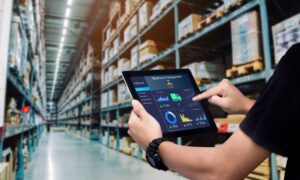Warehouses and distribution centers are proactively integrating technology into their operations, and for good reason. Technology helps supply chain management lower costs, overcome labor shortages, and increase visibility.
Let’s take a look at some of the innovative solutions currently in high demand.
Automation and robotics
Automated solutions are becoming a necessity — increased order volumes and fast delivery expectations make it difficult for manual warehouse management systems to keep up. While technological advancements like driverless deliveries might not be ready for action, there are numerous opportunities for automation and robotics in the warehouse, including:
- Automated software and systems that aid tasks like inventory management, employee tracking, and data collection
- Autonomous mobile robots (AMR), automated guided vehicles (AGV), and material handling equipment
- Worker-assisting solutions like robotic exoskeletons and wearable technology
Tools like these help streamline operations while preventing injuries caused by repetitive and strenuous tasks.
Artificial intelligence (AI)
AI technology strengthens logistics operations by identifying purchasing patterns, like seasonal spikes in demand for certain products.
Here are a few of the advantages AI brings to the table:
- Provides enhanced visibility, allowing suppliers to better predict demands and manage inventory
- Eliminates manual data collection, which cuts labor costs and prevents human errors
- Increases revenue, as the supply chain management industry is among those most likely to experience revenue growth as a result of AI adoption
But this is just the beginning. Other innovative AI technologies, such as machine learning and route optimization, are also emerging in the industry and may soon see increased adoption.
Real-time visibility
Tracking the movement of goods from beginning to end is a complicated process. There may be several points along the journey where blind spots occur, resulting in customers and supply chain personnel losing track of orders.
Using sensors, tracking devices, and software, real-time visibility technologies provide a complete picture of inventory location and movement. This solution will become more essential as customers seek more transparency on the status of their deliveries.
Data collection and analysis
The increased use of technology allows supply chain managers to gather a substantial amount of data. Over time, this information can shape strategic decisions and reveal areas for improvement.
Edge computing and predictive analytics tools help industry professionals interpret data faster and more efficiently, so they don’t have to wait to make important decisions that improve customer satisfaction and keep them one step ahead of their competitors.
Internet of Things (IoT)
The Internet of Things essentially opens up a channel for communication between systems and devices, including the technologies noted above. This network is actively collecting and reporting data and alerting users of potential issues anywhere along the supply chain such as maintenance needs, environmental changes, and unfavorable weather conditions.
Here are a few ways IoT benefits supply chain management:
- Detects problems with equipment and vehicles that could cause damage or malfunctions
- Monitors the condition of goods to prevent spoilage, expiration, loss, and damage
- Strengthens communication between logistics providers, warehouse operators, and customers
- Predicts road conditions, changes in weather, and other circumstances that may require adjustments to routes and schedules
Thanks to the availability of 5G networks, we could see greater adoption of IoT in the near future.
—
If you’re looking for a solution that fits in with these technology trends — aiding data collection, tracking inventory, and adding more automation into your supply chain — learn about the benefits of smart lockers for supply chain management.




